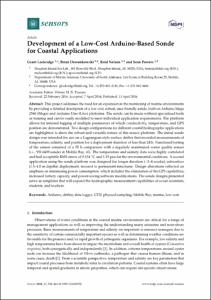| dc.contributor.author | Lockridge, Grant | |
| dc.contributor.author | Dzwonkowski, Brian | |
| dc.contributor.author | Nelson, Reid | |
| dc.contributor.author | Powers, Sean | |
| dc.coverage.spatial | Mobile Bay | en_US |
| dc.date.accessioned | 2023-02-16T21:25:55Z | |
| dc.date.available | 2023-02-16T21:25:55Z | |
| dc.date.issued | 2016 | |
| dc.identifier.citation | Lockridge, G., Dzwonkowski, B., Nelson, R. and Powers, S. (2016) Development of a Low-Cost Arduino-Based Sonde for Coastal Applications. Sensors, 16:528, 16pp. DOI: https://doi.org/10.3390/s16040528 | en_US |
| dc.identifier.uri | https://repository.oceanbestpractices.org/handle/11329/2140 | |
| dc.description.abstract | This project addresses the need for an expansion in the monitoring of marine environments
by providing a detailed description of a low cost, robust, user friendly sonde, built on Arduino Mega
2560 (Mega) and Arduino Uno (Uno) platforms. The sonde can be made without specialized tools
or training and can be easily modified to meet individual application requirements. The platform
allows for internal logging of multiple parameters of which conductivity, temperature, and GPS
position are demonstrated. Two design configurations for different coastal hydrographic applications
are highlighted to show the robust and versatile nature of this sensor platform. The initial sonde
design was intended for use on a Lagrangian style surface drifter that recorded measurements of
temperature; salinity; and position for a deployment duration of less than 24 h. Functional testing
of the sensor consisted of a 55 h comparison with a regularly maintained water quality sensor
(i.e., YSI 6600 sonde) in Mobile Bay, AL. The temperature and salinity data were highly correlated
and had acceptable RMS errors of 0.154 C and 1.35 psu for the environmental conditions. A second
application using the sonde platform was designed for longer duration (~3–4 weeks); subsurface
(1.5–4.0 m depths) deployment, moored to permanent structures. Design alterations reflected an
emphasis on minimizing power consumption, which included the elimination of the GPS capabilities,
increased battery capacity, and power-saving software modifications. The sonde designs presented
serve as templates that will expand the hydrographic measurement capabilities of ocean scientists,
students, and teachers. | en_US |
| dc.language.iso | en | en_US |
| dc.rights | Attribution 4.0 International | * |
| dc.rights.uri | http://creativecommons.org/licenses/by/4.0/ | * |
| dc.subject.other | Arduino | en_US |
| dc.subject.other | Data logger | en_US |
| dc.subject.other | Drifter | en_US |
| dc.subject.other | Sonde | en_US |
| dc.subject.other | Low cost | en_US |
| dc.title | Development of a Low-Cost Arduino-Based Sonde for Coastal Applications. | en_US |
| dc.type | Journal Contribution | en_US |
| dc.description.refereed | Refereed | en_US |
| dc.format.pagerange | 16pp. | en_US |
| dc.identifier.doi | https://doi.org/10.3390/s16040528 | |
| dc.subject.parameterDiscipline | Physical oceanography | en_US |
| dc.subject.instrumentType | CTD | en_US |
| dc.bibliographicCitation.title | Sensors | en_US |
| dc.bibliographicCitation.volume | 16 | en_US |
| dc.bibliographicCitation.issue | Article 528 | en_US |
| dc.description.sdg | 14.a | en_US |
| dc.description.maturitylevel | Pilot or Demonstrated | en_US |
| dc.description.adoption | Novel (no adoption outside originators) | en_US |
| dc.description.methodologyType | Specification of criteria | en_US |
| dc.description.methodologyType | Reports with methodological relevance | en_US |
| obps.contact.contactemail | glockridge@disl.org | |
| obps.resourceurl.publisher | https://www.mdpi.com/1424-8220/16/4/528 | |
 Repository of community practices in Ocean Research, Applications and Data/Information Management
Repository of community practices in Ocean Research, Applications and Data/Information Management

